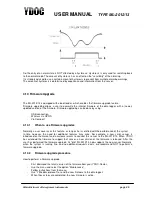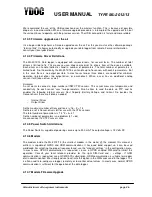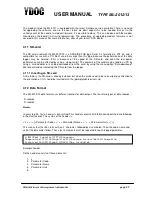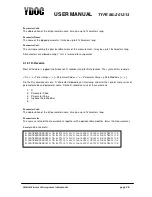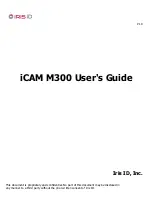
USER MANUAL
TYPE ML-2012/13
Manufacturers of low power instruments
page 29
4.12.2 System-records
The System-records are used to log system related information. System-records do not contain normal
measurements. A system-record is made, when an awkward situation is encountered, for instance, when
a sensor is not replying to a request from the logger. System-records are used for monitoring system-
performance. The syntax of an S-record is:
<’S’> <’;’>,<Timestamp> <’;’> [ <System Message> <’;’> < Additional System Message> <’;’>]
So, the S-record consists of an ‘S’ character followed by a timestamp, and after that, one or more series
of parameter code and parameter name.
So the S-record consists of these elements
1. S
2. System Message
3. Additional System Message
4. ;
System Message:
A short and comprehensive message to explain the type of problem encountered
Additional System Message:
Some more information on the exception
Example S-records:
4.12.3 Data Modifiers
Normally a data value, presented in D-records is recorded without a Data Modifiers, but in case of a
malfunction, or rare circumstances, a Data Modifier is added to the data value. See table below:
Data
Modifier
Description
Remarks
*T
Timeout
The sensor did not provide the data logger with a data value, and the
timeout has expired. The previous data value is recorded, with the
addition of this exception.
*I
Data Invalid
The data logger did receive a data value from the sensor, but it was out
of boundary. This exception is very rare.
*A
Alarm Value
The data logger has received a value, which is outside the limits of the
particular parameter.
S;110922202054;CFG_RESET
S;110922202054;CFG_CHANGED;Brasil_3002389
S;110922202124;MODEM_WDT;STATE 10











